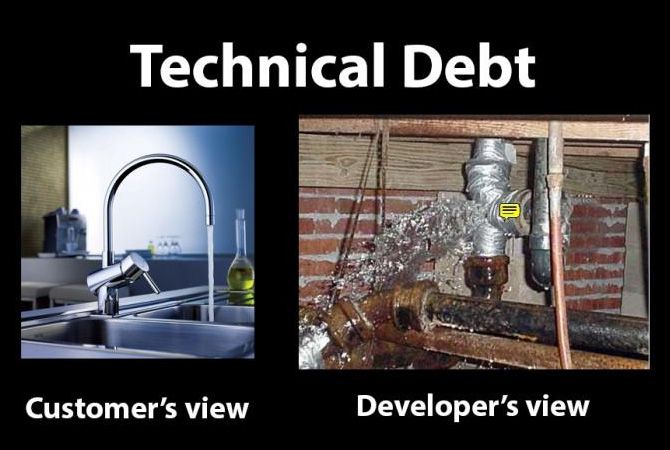The horror behind design

Software Engineering Team Lead and Director of Cloudsure
Improve your craft, write the cleanest code you know how at that point in time, learn from your mistakes (and that of others) and always aim to improve.
I think looking at the plumbing behind many designs could make one stay up for weeks. Now, when I refer to designs in this case I mean anything from a house that was built down to your toaster. How many shortcuts were taken to get the job done?
Technical Debt
In software, we refer to the build up of bad shortcuts as "technical debt" - hacks or bad implementations that build over time that should be fixed in future iterations. In reality, how often do they get attended to?
Looking at the software stack we can see how some decisions and changes that build over time can cause horrors behind the scenes, all the way from graphics to the entire system architecture:
-
Graphics. Think Photoshop. How many revisions of that file exist? How many layers are there? How many layers are actually named?
-
Websites. Think about how many lines appear in each script or stylesheet? How well formatted is the HTML? Are there tables defining the layout? Let's not get started on the optimization of images.
-
Applications & Services. Where is the business logic? What does the mapping or Anti-Corruption Layer look like? What does the configuration file look like? Where are the passwords stored? What does the documentation look like?
-
System architecture. Do you know what servers and services are being used and by whom? Are they routed correctly? Can you easily detect if there is a problem with the load balancing? How do you know if one of the nodes are not responding correctly? Perhaps draw a system diagram of an enterprise system just to shock yourself.
-
Organization. (Heck, let's throw in the business too) What does the company structure of an enterprise organization look like? Draw another diagram just to confuse yourself. How often does it change?
Behind anything that looks appealing is something dark and sinister looming and waiting to jump out at you and scream "BOO!"

There's a big difference between what the customer sees and what the developer sees
We are in the real world where things change rapidly. Deadlines loom, people change, teams change, strategies change, organizations and companies change. So, it seriously becomes tough to keep things looking good under the hood of our applications.
Worst of all, the code you wrote that looks great today will suck in the future and may possibly make someone want to pull their hair out. This someone could be future you.
On the bright side, at least you know you are learning and improving but unfortunately you are actively contributing to today's problems.
It's a harsh reality
Let's pause. Breathe. Before you throw verbal rocks at me, or even worse, throw your craft out the window, hear me out.
-
I apologize for painting this depressing picture. I didn't do it to instill doom and gloom, I promise.
-
We can't use these issues as a scapegoat. Imagine the horrors we would face if we didn't actually try our best.
Accept it
I highlighted the reality because a while ago I was crippled by the concept of clean code. I became a digital neat freak and I was fighting a losing battle. I became so particular with practices, principles and the opinions of others that I didn't want to write code anymore.
Now that's a terrible place to be in. When you are cognizant of code smells,
then code smells stand out like NullReferenceException's.
Accept that code will never be perfect.
Free yourself
I believe that great software developers know that their code is not great. They know that they aren't digital gods amongst mere mortals. They are aware of trade-offs and the impact of their decisions. And one day they will look back on their code and think "what the hell was I trying to do here?" But they try and they improve.
Knowing this makes contributing to source code less daunting. Let this free yourself from any debilitating feelings you may have when it comes to writing code.
Just try your best
The practices, principles and opinions others have are born from mistakes that were made in the past. It's important to add this to your development toolbox and know what to use and when. Just try your best.
Be kind to others
When you see someone is writing code (or has written code) that could cause a potential meltdown, either to you or to the production environment, kindly let the person know why the implementation is not a good idea.
Being harsh without practical validation only creates a negative environment where people choose not to collaborate.
You can't change the way people think but you can positively influence them.
My final thoughts
We need to be less harsh on ourselves and on others. The best we can do is try to improve our craft, write the cleanest code we know how at that point in time, learn from our mistakes (and that of others) and always aim to improve.
Summary
- Accept that code will never be perfect.
- Even the best software developers make mistakes.
- Just try your best.
- Learn from your mistakes and that of others.
- You can't change the way people think but you can positively influence them.
Learning materials
-
Code Complete: A Practical Handbook of Software Construction, Second Edition by Steve McConnell
-
The Clean Coder: A Code of Conduct for Professional Programmers, First Edition by Robert C. Martin
-
Clean Code A Handbook of Agile Software Craftsmanship, First Edition by Robert C. Martin
-
Design Patterns: Elements of Reusable Object-Oriented Software, First Edition by Erich Gamma


